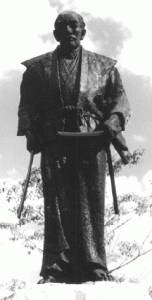 Tokugawa Yeyasu – the Shogun, ruler of Japan
Tokugawa Yeyasu – the Shogun, ruler of Japan
Oda Nobunaga – the initiator of the unification of Japan
Toyotomi Hideyoshi – Oda Nobunaga’s former liege lord and successor
Toyotomi Hideyori – the son of Hideyoshi, ruler of Osaka Castle and rival of Ieyasu
Kobayakawa Hideaki – supposedly and ally of the Western Army, at Sekigahara he fought for Ieyasu’s Eastern Army
Ishida Mitsunari – general in the Western Army, Takezo and Matahachi were foot soldiers under his command
Ukita, Shimazu, Konishi – generals in the Western Army
Sanada Yukimura – Tokugawa’s enemy hiding in Mount Kudo
Sengoku Soya – Tokugawa’s enemy hiding around the Horyuji
Ban Dan’emon – Tokugawa’s enemy hiding at the Kofukuji
Taira no Masakado – 10th century rebel and, subsequently, ruler of Japan
Fujiwara no Sumitomo – 10th century rebel and, subsequently, ruler of Japan
Fujiwara no Michinaga – former regent
Bodhisattva Nagarjuna – famous Buddhist monk
Gudo of the Myoshinji – famous Japanese holy man
Itto of Sennan – famous Japanese holy man
Karasumaru – famous nobleman
Hosokawa – famous general of the Hosokawa clan
Akamatsu Masanori – once lord of Himeji Castle
Toda Seigen – swords master from Kurotani
Ogasawara Genshinsai – swords master from Kitano
Ito Ittosai – swords master from Shirakawa
Kiichi Hogen – famous strategist and sword master
Ts’ao Ts’ao of Wei and Ch’u-ko K’ung-ming – historical Chinese generals
Prince Hiromasa – a legendary prince who played the flute together with a devil at Suzaku Gate in Kyoto
Empress Komyo – (701-760) was the Nara period consort of Japanese Emperor Shōmu (701-756)
Hachiman – the Japanese god of war
Publishing details: Musashi – Book 1: The Way of the Samurai by Eiji Yoshikawa, Corgi Books, Translated from the Japanese by Charles S. Terry, Foreword by Edwin O. Reischauer, 1990, 302 p.
